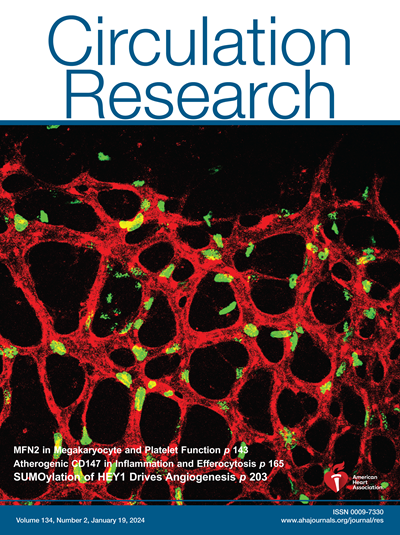GPLD1通过双膜定位抑制uPAR减轻心力衰竭。
IF 16.2
1区 医学
Q1 CARDIAC & CARDIOVASCULAR SYSTEMS
引用次数: 0
摘要
背景:尽管GPLD1(糖基磷脂酰肌醇特异性磷脂酶D1)在年龄相关损伤中的作用已经确立,但其在心血管疾病中的作用仍不清楚。方法分析心力衰竭(HF)患者和小鼠心脏组织中GPLD1转录本和蛋白水平。遗传学方法,包括心脏特异性缺失、GPLD1过表达或突变,以及心肌内注射腺相关病毒9介导的GPLD1过表达或其shRNA转导,用于评估GPLD1在横断主动脉收缩诱导的HF小鼠模型中的功能作用。蛋白质组学分析确定了候选结合靶点,并使用邻近连接试验和共免疫沉淀等方法对其进行了验证。uPAR(尿激酶型纤溶酶原激活剂受体)过表达或shRNA靶向uPAR来询问机制途径。通过膜脂分析和质膜和线粒体区室的亚细胞分离来研究GPLD1的亚细胞定位。用pRS426GFP-2×PH (PLC[磷脂酶C] δ)转染心肌细胞,监测磷脂酰肌醇4,5-二磷酸水平。通过测定细胞质和线粒体钙水平、线粒体通透性、过渡开孔率和耗氧量来评估细胞稳态和生物能量学。结果HF患者和小鼠模型中gpld1水平升高。心脏特异性GPLD1缺失加重心功能障碍和肥厚,而其过表达则根据酶活性改善这些影响。uPAR被确定为GPLD1的潜在结合靶点,病毒介导的uPAR转导完全消除了主动脉横缩手术后GPLD1的保护作用。机制上,GPLD1通过磷脂酰肌醇4,5-二磷酸锚定在质膜和线粒体外膜上,裂解uPAR的糖基磷脂酰肌醇锚定,从而维持钙稳态和线粒体功能,最终改善心功能障碍。相反,过量的uPAR导致磷脂酰肌醇4,5-二磷酸水平降低,阻止GPLD1定位到这些膜并使其分散在细胞质中。结论GPLD1是一种内源性的心衰保护因子,可能是治疗心功能障碍和心衰的一个有希望的靶点。本文章由计算机程序翻译,如有差异,请以英文原文为准。
GPLD1 Attenuates Heart Failure via Dual Membrane Localization to Inhibit uPAR.
BACKGROUND
Despite the established role of GPLD1 (glycosylphosphatidylinositol-specific phospholipase D1) in age-related impairments, its involvement in cardiovascular diseases remains unclear.
METHODS
We analyzed GPLD1 transcript and protein levels in heart tissues from patients with heart failure (HF) and murine HF models. Genetic approaches, including cardiac-specific depletion, overexpression, or mutation of GPLD1, alongside intramyocardial injection of adeno-associated virus 9-mediated GPLD1 overexpression or its shRNA transduction, were used to assess the functional role of GPLD1 in transverse aortic constriction-induced HF mouse models. Proteomic profiling identified candidate binding targets, which were validated using methods including proximity ligation assay and coimmunoprecipitation. uPAR (urokinase-type plasminogen activator receptor) overexpression or shRNA targeting uPAR was performed to interrogate mechanistic pathways. Subcellular localization of GPLD1 was investigated through membrane lipid analysis and subcellular fractionation of plasma membrane and mitochondrial compartments. Cardiomyocytes were transfected with pRS426GFP-2×PH (PLC [phospholipase C] δ) to monitor phosphatidylinositol 4,5-bisphosphate levels. Cytosolic and mitochondrial calcium levels, mitochondrial permeability transition pore opening, and oxygen consumption rate were measured to evaluate cellular homeostasis and bioenergetics.
RESULTS
GPLD1 levels were elevated in patients with HF and murine models. Cardiac-specific GPLD1 depletion exacerbated cardiac dysfunction and hypertrophy, while its overexpression ameliorated these effects, depending on enzymatic activity. uPAR was identified as a potential binding target for GPLD1, and viral-mediated uPAR transduction completely abolished the protective effects of GPLD1 following transverse aortic constriction surgery. Mechanistically, GPLD1 was anchored to the plasma membrane and outer mitochondrial membrane via phosphatidylinositol 4,5-bisphosphate to cleave the glycosylphosphatidylinositol anchor of uPAR, thereby maintaining calcium homeostasis and mitochondrial function, and ultimately ameliorating cardiac dysfunction. Conversely, excess uPAR led to a decrease in phosphatidylinositol 4,5-bisphosphate levels, preventing GPLD1 from localizing to these membranes and causing it to disperse in the cytoplasm.
CONCLUSIONS
Our studies identify GPLD1 as an endogenous protective factor against HF and suggest that it may be a promising therapeutic target for cardiac dysfunction and HF.
求助全文
通过发布文献求助,成功后即可免费获取论文全文。
去求助
来源期刊

Circulation research
医学-外周血管病
CiteScore
29.60
自引率
2.00%
发文量
535
审稿时长
3-6 weeks
期刊介绍:
Circulation Research is a peer-reviewed journal that serves as a forum for the highest quality research in basic cardiovascular biology. The journal publishes studies that utilize state-of-the-art approaches to investigate mechanisms of human disease, as well as translational and clinical research that provide fundamental insights into the basis of disease and the mechanism of therapies.
Circulation Research has a broad audience that includes clinical and academic cardiologists, basic cardiovascular scientists, physiologists, cellular and molecular biologists, and cardiovascular pharmacologists. The journal aims to advance the understanding of cardiovascular biology and disease by disseminating cutting-edge research to these diverse communities.
In terms of indexing, Circulation Research is included in several prominent scientific databases, including BIOSIS, CAB Abstracts, Chemical Abstracts, Current Contents, EMBASE, and MEDLINE. This ensures that the journal's articles are easily discoverable and accessible to researchers in the field.
Overall, Circulation Research is a reputable publication that attracts high-quality research and provides a platform for the dissemination of important findings in basic cardiovascular biology and its translational and clinical applications.
 求助内容:
求助内容: 应助结果提醒方式:
应助结果提醒方式:


